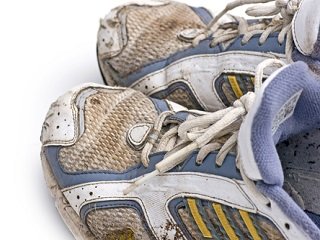 It’s easy to put a lot of miles on your shoes without even realizing it, and before you know it, it may be time to invest in a new pair. This is a good thing, to be sure, since it means you’re getting some good cardio activity in your life, but a worn pair of shoes can become uncomfortable and actually hinder your workout. How do you know when it’s time to put your current pair out to pasture, though? Well, today I’ve provided you with a few tips to help you take notice of when it’s time to pick up a new pair of running shoes for the trail or for the road.
It’s easy to put a lot of miles on your shoes without even realizing it, and before you know it, it may be time to invest in a new pair. This is a good thing, to be sure, since it means you’re getting some good cardio activity in your life, but a worn pair of shoes can become uncomfortable and actually hinder your workout. How do you know when it’s time to put your current pair out to pasture, though? Well, today I’ve provided you with a few tips to help you take notice of when it’s time to pick up a new pair of running shoes for the trail or for the road.
As a general rule, most running and walking shoes last up to 500 miles. Though, how, how often, and where you wear your shoes can impact the amount of mileage you can put on them. For example, pavement wears down shoes faster than a track, a trail or gravel, so excessive activity on pavement will shorten you’re the lifespan of your shoes.
It’s smart to pay attention to how your shoes look. It doesn’t matter how dirty they are; instead, you should be concerned with the presence of general wear and tear. Are the heels stretched out? Worn down spots on the outsoles? Can you see how the shoes have molded to your foot? These are all signs of excessive wear and could mean that it’s time to pick up a new pair.
Another way to determine if the midsoles of your shoes are compressed and are no longer providing cushioning is the press test. Using your thumb, push on the outsole upward into the midsole. With new shoes, it should be easy to see the midsole compress into lines or wrinkles. As the shoe wears down, though, the midsole will compress less with the same amount of pressure from your thumb. When the midsole shows heavy compression lines and the press test reveals a minimal amount of compression, there is little or no cushioning left, which means it’s time to go shoe shopping.
Lastly, your body will feel when there is little or no cushioning left in your shoes, and it will tell you in the form of any aches or pains in your feet, legs, knees, hips or back after you’ve worn your shoes. Also, pay attention to friction or blisters in unexpected places, which means your shoes have stretched and your feet are moving around too much.
You can take measures to extend the life of your running shoes, though. One way is to keep two or three pairs of running shoes that you can alternate using. You’ll find they’ll last much longer in the long run, no pun intended. Also, if you take off your shoes properly—by unlacing them and removing them with your hand instead of kicking your shoe off with the other foot—they’ll last much longer, as well. Lastly, it’s smart to designate your shoes for running and nothing else. Wearing your exercise shoes around the house or around town will wear them down more quickly.
Like I said, worn down running shoes are actually a good thing. It means you’re getting a lot of use out of them and hence, a lot of exercise. However, they aren’t made to last forever and need to be replaced. The tips listed above will help you recognize when it’s time to replace your own shoes, and also how to add a few miles to your current pair’s lifespan.








